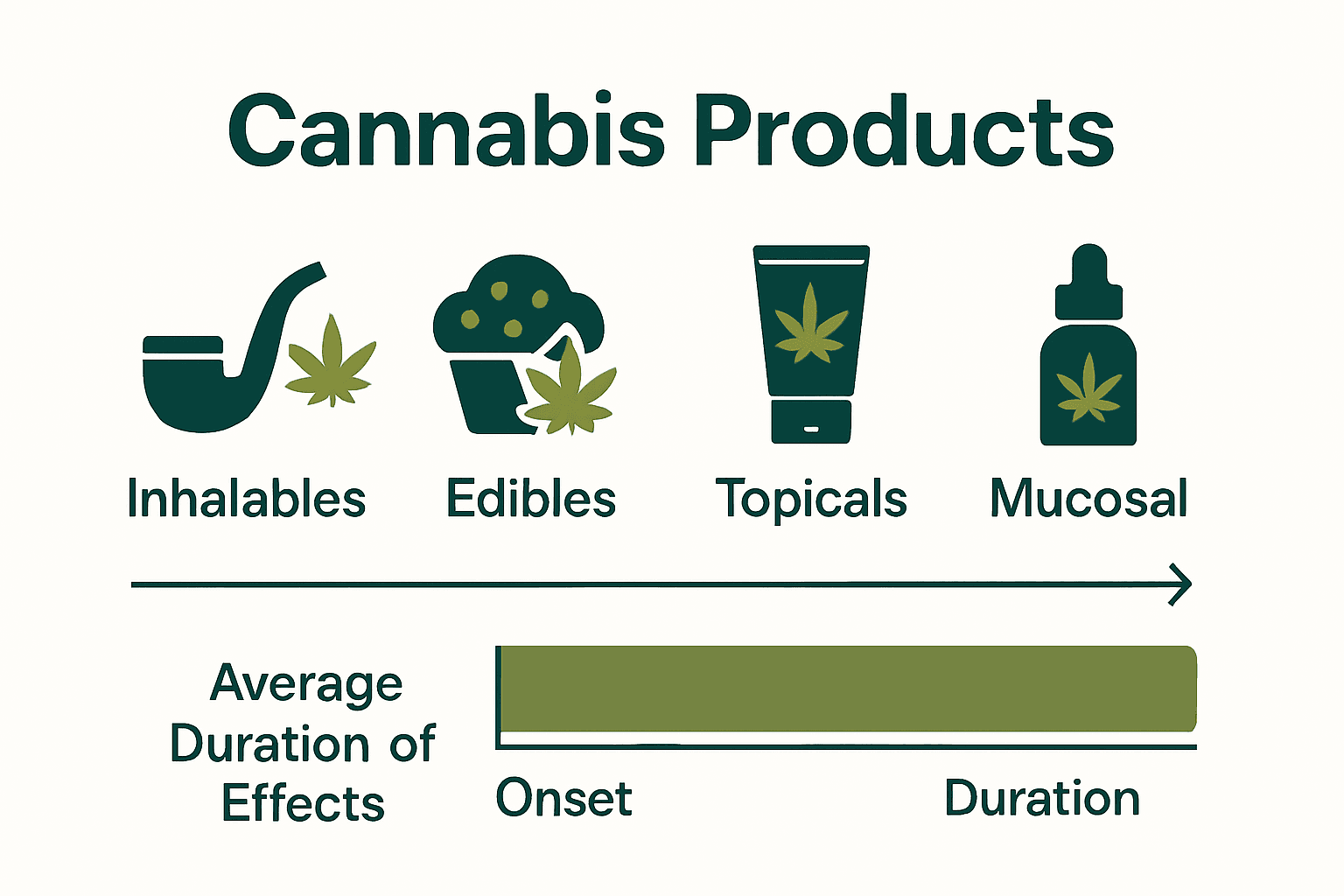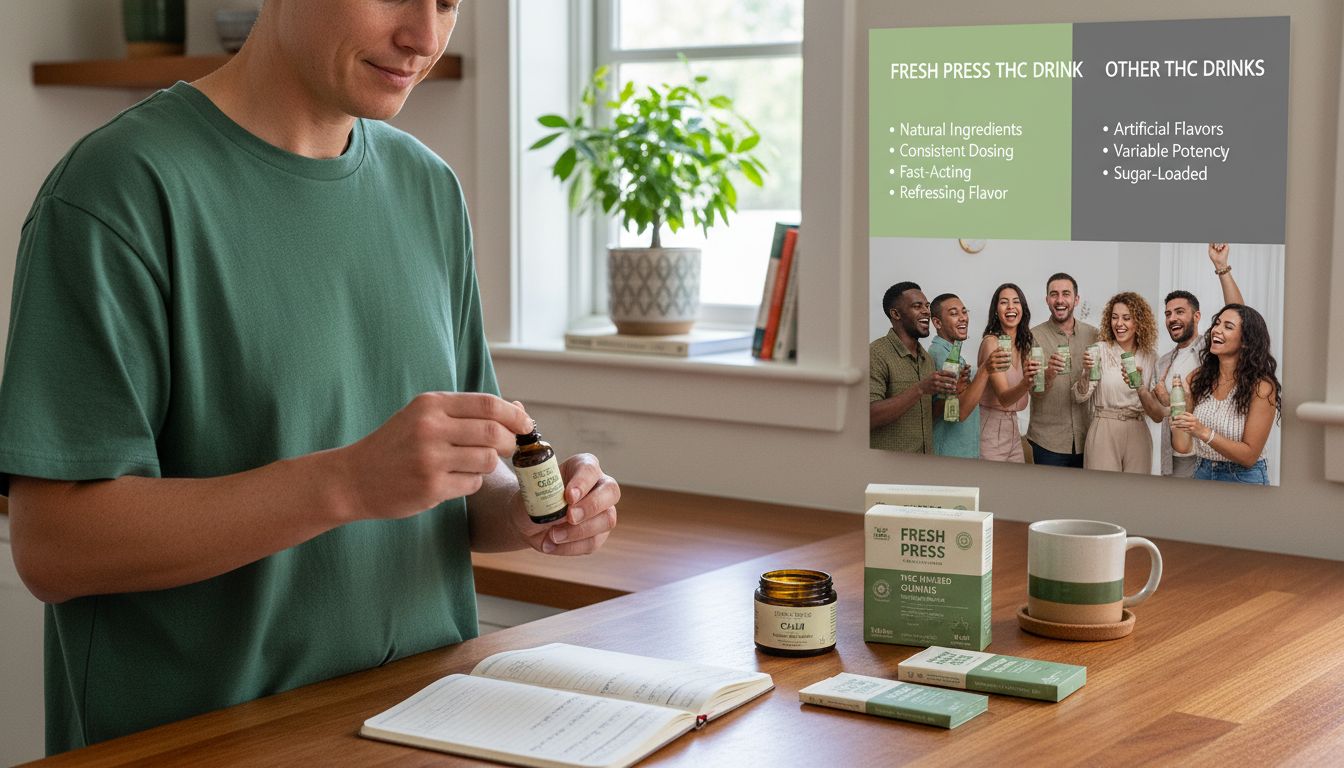More than 48 million Americans report using cannabis each year, yet confusion and myths continue to cloud public understanding. Whether you are curious about cannabis for wellness, exploring different product types, or worried about potential health risks, misinformation can make these choices much harder. This guide brings together scientific insights and practical advice to help you see cannabis with clarity and confidence.
Table of Contents
- Cannabis Basics And Common Misconceptions
- Types Of Cannabis And Product Forms
- How Cannabis Affects Your Body
- Current Cannabis Laws By U.S. State
- Safe Use, Dosage, And Wellness Tips
- Potential Risks And What To Avoid
Key Takeaways
| Point | Details |
|---|---|
| Understanding Cannabis | Cannabis is a complex plant with various cannabinoids; THC and CBD are the most known compounds affecting both the body and mind. |
| Consumption Methods | Cannabis products come in multiple forms (inhalables, edibles, topicals), each with distinct effects and onset times that cater to individual preferences and wellness goals. |
| Safety and Dosage | Start with low doses, understand your product’s potency, and consume in a safe environment to ensure a positive experience. |
| Potential Risks | Cannabis use can have risks, including cognitive impairment and psychological dependence, especially in vulnerable populations; mindful consumption is essential. |
Cannabis Basics And Common Misconceptions
Cannabis is a complex plant with a rich history and nuanced effects that often gets misunderstood. Cannabis refers to a group of plants containing multiple chemical compounds called cannabinoids, with THC and CBD being the most well-known. According to CDC, these plants come in various forms and can be consumed through multiple methods including smoking, vaping, edibles, and topical applications.
One of the most persistent misconceptions about cannabis involves its potential for addiction and impact on health. Utah Department of Health highlights that while cannabis can create psychological dependence, not everyone who uses it becomes addicted. Critical factors like frequency of use, individual physiology, and underlying mental health conditions play significant roles in determining potential dependency risks.
Common Cannabis Misconceptions:
- Cannabis is a “gateway drug” (scientifically unproven)
- All cannabis products produce intense psychoactive effects
- Cannabis has zero medical benefits
- Consumption methods have identical impacts
Understanding cannabis requires moving beyond stereotypes and approaching the topic with nuanced, evidence-based perspectives. What Are THCA and THC? Differences and Effects Explained provides deeper insights into the plant’s complex chemical profile. The key is recognizing cannabis as a sophisticated botanical with potential wellness applications when used responsibly and with proper knowledge.
For those newly exploring cannabis, starting with low doses, understanding personal tolerance, and consulting healthcare professionals can help create a safe, informed consumption experience. Educate yourself, ask questions, and approach cannabis with an open yet cautious mindset.
Types Of Cannabis And Product Forms
Cannabis comes in a diverse array of product forms designed to suit different preferences, consumption methods, and wellness goals. Washington State Liquor and Cannabis Board outlines several primary categories of cannabis products, each offering unique experiences and potential benefits. Inhalable products like loose flower and concentrates provide rapid onset of effects, while alternative consumption methods offer more controlled and discrete experiences.
According to the New York State Medical Cannabis Program, cannabis products can be broadly categorized into four main types:
- Inhalables: Smoking or vaporizing cannabis flower or concentrates
- Edibles: Cannabis-infused foods and beverages
- Topicals: Lotions, balms, and skin-applied products
- Mucosal Products: Tinctures, sprays, and sublingual applications
Each product form offers distinct absorption rates, duration of effects, and potential therapeutic applications. 7 Types of Cannabis Products to Enhance Your Wellness provides deeper insights into how different consumption methods can align with individual wellness objectives. The key is understanding your personal needs, tolerance levels, and desired outcomes.

For newcomers, starting with low-dose options and consulting healthcare professionals can help navigate the complex landscape of cannabis products. Experimenting responsibly, understanding product potency, and being mindful of individual reactions will ensure a safe and enjoyable cannabis experience.

How Cannabis Affects Your Body
Cannabis interacts with the human body through a complex network of biological systems, primarily targeting the endocannabinoid system. Centers for Disease Control explains that the primary psychoactive compound THC directly impacts brain chemistry, binding to cannabinoid receptors throughout the nervous system and creating a range of physiological and psychological effects.
According to the National Institute on Drug Abuse, cannabis can produce significant neurological impacts, particularly on cognitive functions. The primary effects include:
- Altered mood and perception
- Potential short-term memory impairment
- Changes in reaction time
- Potential impacts on brain development, especially in younger users
- Modulation of pain perception and stress response
Physiological Responses: Different consumption methods can trigger varied bodily responses. Drinking THC: Effects, Benefits, and Safe Consumption Tips highlights how ingestion methods dramatically influence absorption rates and overall experience. Inhalation provides rapid onset, while edibles create a slower, more prolonged effect due to metabolic processing.
Understanding individual body chemistry is crucial. Factors like metabolism, tolerance, frequency of use, and personal health conditions significantly influence how cannabis interacts with your system. Always start with low doses, remain hydrated, and listen to your body’s unique responses. Consulting healthcare professionals can provide personalized insights into how cannabis might specifically affect your individual physiology.
Current Cannabis Laws By U.S. State
Cannabis legislation varies dramatically across the United States, creating a complex legal landscape for consumers and businesses. National Conference of State Legislatures reveals that states have fundamentally different approaches to cannabis regulation, ranging from complete prohibition to full recreational legalization.
According to the comprehensive research, state cannabis laws can be categorized into several key classifications:
- Fully Recreational: States allowing both medical and adult-use cannabis
- Medical Only: States permitting cannabis exclusively for medical purposes
- Decriminalized: States reducing criminal penalties without full legalization
- Prohibited: States maintaining strict criminal sanctions against cannabis
THC Drinks in Minnesota: Laws, Effects & Where to Buy highlights how regional variations can significantly impact cannabis accessibility. The National Conference of State Legislatures emphasizes that medical marijuana laws particularly demonstrate wide-ranging differences, with some states offering comprehensive programs while others maintain extremely restrictive frameworks.
Navigating this legal complexity requires careful research and understanding of your specific state’s regulations. Always verify current local laws, as cannabis legislation continues to evolve rapidly. Potential consumers should consult local authorities, review state-specific guidelines, and stay informed about ongoing legislative changes to ensure full legal compliance.
Safe Use, Dosage, And Wellness Tips
Cannabis consumption requires thoughtful approach and mindful practices to ensure a safe, positive experience. Substance Abuse and Mental Health Services Administration emphasizes the importance of understanding personal tolerance, starting with low doses, and creating a controlled consumption environment.
Key wellness and safety guidelines include:
- Start Low, Go Slow: Begin with minimal doses and gradually increase
- Know Your Product: Understand THC/CBD percentages and potential effects
- Create a Safe Environment: Consume in comfortable, familiar settings
- Stay Hydrated: Drink water before, during, and after consumption
- Avoid Mixing: Do not combine with alcohol or other substances
Microdosing with Cannabis Beverage Enhancers: A New Frontier provides insights into controlled, intentional cannabis consumption. Microdosing allows users to experience subtle benefits while minimizing potential overwhelming effects, making it an excellent strategy for beginners seeking wellness support.
Personal responsibility is paramount. Listen to your body, understand your individual physiological responses, and never hesitate to seek professional medical advice. Your cannabis journey should be about enhancing wellness, exploring personal comfort levels, and creating a positive, intentional experience tailored to your unique needs.
Potential Risks And What To Avoid
Cannabis consumption carries potential risks that demand careful consideration and informed decision making. National Institute on Drug Abuse highlights significant neurological implications, particularly regarding cognitive function and potential long-term brain development impacts.
Key risks and potential negative outcomes include:
- Cognitive Impairment: Potential memory and concentration challenges
- Mental Health Interactions: Possible exacerbation of anxiety or depression
- Addiction Potential: Risk of psychological dependence
- Respiratory Issues: Potential lung irritation from smoking
- Interaction with Medications: Possible adverse drug interactions
Vulnerable Populations require special consideration. Young adults, individuals with pre-existing mental health conditions, and those with a family history of substance abuse should exercise extreme caution. Beyond THC: Why Minor Cannabinoids Like CBG and CBN Deserve the Spotlight suggests exploring alternative cannabinoid profiles that might offer more balanced experiences with potentially reduced risk.
Proactive risk management involves comprehensive self-awareness. Regular medical consultations, honest self-assessment of personal reactions, and maintaining open communication with healthcare providers are crucial strategies. Always prioritize your physical and mental well-being, and approach cannabis consumption with thoughtful, informed intentionality.
Begin Your Cannabis Journey with Confidence and Wellness
Starting with cannabis can feel overwhelming due to questions about dosage, product types, and effects. This guide highlights common challenges such as understanding different cannabinoids, managing safe intake, and finding the right product to match your wellness goals. Whether you’re curious about THC’s psychoactive effects or CBD’s calming benefits, exploring options thoughtfully is key.
Discover expertly crafted options at 23rd State that support a personalized experience with premium hemp-derived products. From our carefully selected THC collection to soothing offerings in the CBD collection, we have something designed to fit your pace and preferences.

Take the next step toward wellness and lifestyle enhancement today. Visit 23State to explore quality cannabis products, enjoy free shipping, and benefit from ongoing promotions. Your safe and enjoyable cannabis experience starts here.
Frequently Asked Questions
What is cannabis and what are its main components?
Cannabis is a group of plants containing various chemical compounds called cannabinoids, with THC (tetrahydrocannabinol) and CBD (cannabidiol) being the most well-known. These compounds interact with the body’s endocannabinoid system to produce varying psychoactive and therapeutic effects.
What are the different types of cannabis products available?
Cannabis products can be categorized into four main types: inhalables (such as smoking or vaporizing flower and concentrates), edibles (cannabis-infused foods and beverages), topicals (skin-applied products like lotions and balms), and mucosal products (tinctures and sprays). Each type offers unique experiences and absorption rates.
How does cannabis affect the body and mind?
Cannabis primarily interacts with the endocannabinoid system, impacting brain chemistry and producing various effects such as altered mood, memory impairment, and changes in pain perception. The effects can vary widely based on the method of consumption and individual physiology.
What safety tips should beginners follow when using cannabis?
Beginners should start with low doses to assess tolerance, know their product’s THC and CBD percentages, consume in a safe and comfortable environment, stay hydrated, and avoid mixing cannabis with alcohol or other substances to ensure a positive experience.

